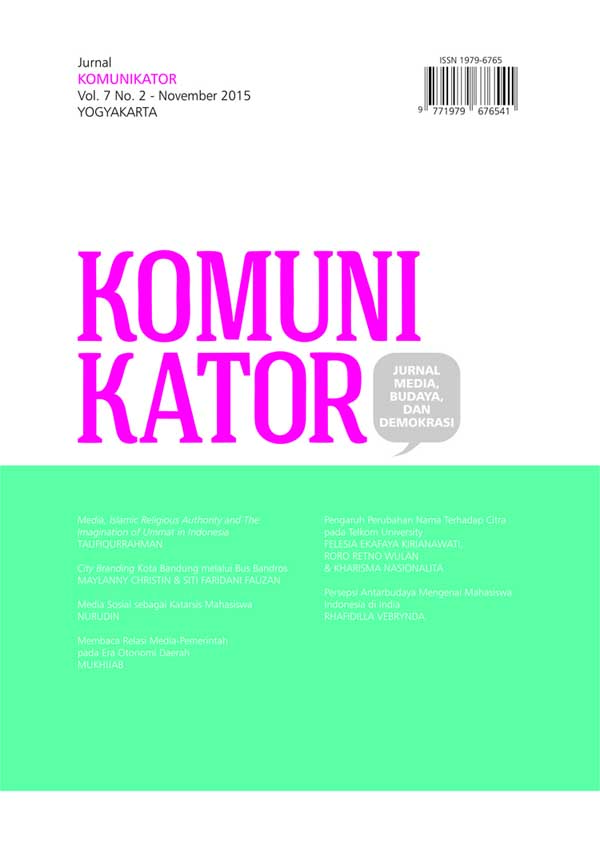The Impact of Renaming STT Telkom being Telkom University to Image of Telkom University
Abstract
Telkom University is one of university in Bandung, was established on August 14, 2013. Telkom University was transformed of STT Telkom which standing on 1990. Based on observation which held by researcher, many people still consider that Telkom University still same with STT Telkom. But actually the case is Telkom University have different identity with STT Telkom. That’s problem surely will be influence to image of Telkom University. This research have purpose to know how the relation name changes of STT Telkom being Telkom University about image of Telkom University to Bandung society. The theories used in this research are the public relation theory as a grand theory, rebranding theory as a middle theory, and then renaming theory and corporate image theory as an applied theory. This study is using the assosiatif methods, that is to find relation about independent variable and dependent variable. Using with survey methods to the 200 Bandung society as the respondents were selected using multistage of cluster sampling techniques. To determine the relation both of this variable in this research, used deskriptive techniques, pearson correlation techniques and also regression technique. The result showed that there are positive relation and significant between renaming of STT Telkom being Telkom University to image of Telkom University in Bandung Society.References
Alifahmi, Hifni. (2012). Marketing Communication Orchestra: Harmonisasi Iklan, Promosi, Dan Marketing Public Relation. Cet ke-3. Bandung: Examedia Publishing.
Anggoro, M Linggar. (2000). Teori & Profesi Kehumasan Serta Aplikasinya Di Indonesia. Jakarta: PT Bumi Aksara.
Ardianto, Elvinaro. (2011). Handbook Of Public Relation: Pengantar Komprehensif. Bandung: Simbiosa Rekatama Media.
Cutlip., Scott M., Center Allen & Broom Glen M. (2009). Effective Public Relations. USA: Prentice Hall.
Jefkins, Frank. (2003). Public Relations. Jakarta: Erlangga.
Kapferer, J., N. (1997). Strategic Brand Management: New Approaches to Creating and Evaluating Brand Equity. New York: The Free Press.
Keller, Kevin., Tony Aperia., Mats Georgson. (2008). Strategic Brand Management: A European Perspective. USA: Prentice Hall.
Knapp, Duane. (2004). The Complete Ideal’s Guide Brand Management. Jakarta: Prenada Media.
Kotler, Philip & Kevin L. Keller. (2009). Marketing Management 13th Edition. New Jersey: Prentince Hall International, Inc..
Muzellec, Laurent., Mary Lambkin and Manus Doogan. (2003). “Corporate Rebranding: An Exploratory Review”. Irish Marketing Review, Vol 16, No 2, pp 31-40.
Muzellec, Laurent., Mary Lambkin and Manus Doogan. (2006). Corporate Rebranding Destroying, Transfering or Creating Brand Equity. Journal of Marketing. Vol 40 No 7/8 pp 803-824.
Rangkuti, Freddy. (2008). The Power of Brands: Teknik Mengelola Brand Equity dan Strategi Pengembangan Merek. Jakarta: Gramedia.
Riduwan & Akdon. (2009). Rumus dan Data Dalam Analisis Statistika. Bandung: Alfabeta.
Riel, Van., Cees., Charles J Fombrun. (2007). Essentials of Corporate Communications: Implementing Practice for Effective Reputation Management. USA: Routledge - Taylor & Francis e-Library.
Ruslan, Rosady. (2002). Kiat dan Strategi Public Relation. Jakarta: Grafindo Persada.
Shimp, Terence A. (2003). Periklanan Dan Promosi. Edisi kelima. Jakarta: Erlangga.
Smith, Paul R. (1995). Marketing Communication an Integrated Approach 2nd Edition. London: Kogan Page.
Siregar, Syofian. (2013). Metode Penelitian Kuantitatif. Edisi Pertama. Jakarta: Kencana Prenada Media.
Susanto, A.B & Wijanarko Himawan. (2004). Power Branding: Membangun Brand Yang Legendaris. Jakarta: Mizan.
Sutisna. (2002). Perilaku Konsumen & Komunikasi Pemasaran. Cetakan Kedua. Bandung: PT Remaja Rosdakarya.
Downloads
Additional Files
Published
Issue
Section
License
Copyright
The Authors submitting a manuscript do so on the understanding that if accepted for publication, copyright of the article shall be assigned to Komunikator as publisher of the journal. Copyright encompasses rights to reproduce and deliver the article in all form and media, including reprints, photographs, microfilms, and any other similar reproductions, as well as translations.
Authors should sign Copyright Transfer Agreement when they have approved the final proofs sent by Komunikator prior the publication. Komunikator strive to ensure that no errors occur in the articles that have been published, both data errors and statements in the article.
Komunikator keep the rights to articles that have been published. Authors are allowed to use their works for any purposes deemed necessary without written permission from Komunikator with an acknowledgement of initial publication in this journal.
License
All articles published in Komunikator are licensed under a Creative Commons Attribution-ShareAlike 4.0 International (CC BY-SA) license. You are free to:
- Share — copy and redistribute the material in any medium or format
- Adapt — remix, transform, and build upon the material for any purpose, even commercially.
- Attribution — You must give appropriate credit, provide a link to the license, and indicate if changes were made. You may do so in any reasonable manner, but not in any way that suggests the licensor endorses you or your use.
- ShareAlike — If you remix, transform, or build upon the material, you must distribute your contributions under the same license as the original.
- No additional restrictions — You may not apply legal terms or technological measures that legally restrict others from doing anything the license permits.





